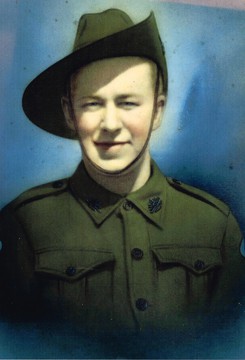NEWPORT, Norman Cecil
| Service Number: | QX11155 |
|---|---|
| Enlisted: | 18 July 1940 |
| Last Rank: | Corporal |
| Last Unit: | 2nd/26th Infantry Battalion |
| Born: | Ballina, New South Wales, Australia, 12 October 1917 |
| Home Town: | Clifton, Toowoomba, Queensland |
| Schooling: | Spring Creek School, Queensland, Australia |
| Occupation: | Farm Labourer |
| Died: | Allora, Queensland , Australia, 9 August 1978, aged 60 years, cause of death not yet discovered |
| Cemetery: |
Allora Cemetery, Qld |
| Memorials: | Ballarat Australian Ex-Prisoners of War Memorial |
World War 2 Service
| 18 Jul 1940: | Involvement QX11155 | |
|---|---|---|
| 18 Jul 1940: | Enlisted | |
| 18 Jul 1940: | Enlisted Australian Military Forces (WW2) , Corporal, QX11155, 2nd/26th Infantry Battalion | |
| 1 Mar 1946: | Discharged Australian Military Forces (WW2) , Corporal, QX11155, 2nd/26th Infantry Battalion |
Help us honour Norman Cecil Newport's service by contributing information, stories, and images so that they can be preserved for future generations.
Add my storyBiography contributed by Cheryl Thompson
Biography written by Lyn Wright (daughter) for the Allora And District Historical Society. Reproduced here with the permission of the author (11 April 2022)
Norman Cecil Newport was the fifth of ten children born to parents John Wesley and Margaret Elizabeth (nee Walsh) Newport. He attended the Spring Creek school, then worked on the family farm and neighbouring farms. By all accounts he was a bit of a larrikin.
At aged 23 he rode his motor bike to join the AIF recruiting office at the Allora police station where he was directed on to Warwick. Norm’s bike was unregistered but the Allora sergeant told him that if he was pulled up to refer them back to him.
After initial training, Norm was assigned to the 2/26 Infantry Battalion formed in October 1940, commanded by Lieutenant Colonel Boyes who was a strict disciplinarian. Under Boyes the 700 troops were moulded into a very efficient fighting force with the name ’The Gallopers’ because of his intense active training regime. Norm was to become a member of the Mortar Platoon. The Mortar Platoon, over a three month period trained intensively with very little leave, to acquire the knowledge and skill in the specific and strategic use of the 3 inch mortar guns.
During the ten weeks of fighting down the Malayan peninsular as No.1 gunner, his sergeant said that Norm’s competence and adherence to duty were a great inspiration to others, with his quiet, persistent and accurate attention to his role in the team.
Norm’s calm nature and his fitness would have hepled him to deal with the deprivation and harsh conditions as a prisoner of war. He was part of the notorious F Force that were made to walk 300 miles through the jungle to work on the Burma-Thailand railway.
Norm came home after three years as a POW. He never talked about his ordeal, who would have believed how they had suffered at the hands of their Japanese captors.
Norm purchased a property adjoining the family farm and became a successful farmer but ever mindful to enjoy life. He loved fishing and camping at the beach.
Sadly he died at only 61. His early death attributed to the malnutrition and harsh treatment he suffered as a POW.









